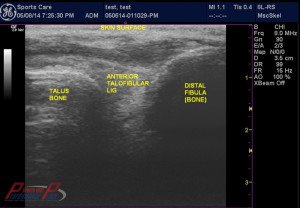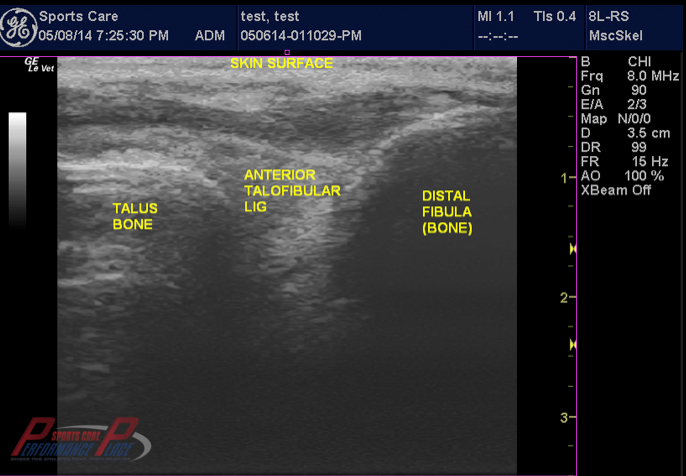Chronic Ankle Instability
Chronic Ankle Instability is theorized to be from two reasons:
Mechanical instability
Functional instability
What is Mechanical Instability of the Ankle?
Mechanical Instability would be found in the situation of a major tear of the ligaments stabilizing the ankle.
What is Functional Instability of the Chronic Ankle Instability of the Ankle?
Functional Instability is a theory that has not has much research-based weight backing it, but it’s being found that mechanical instability alone can not be the only reason. Theory says rehabilitation exercises affect the proprioception receptors of the ligaments but some studies have put that reasoning on the back burner.

Chronic Ankle Instability can be evaluated using MSK Ultrasound. It is a movement related study and allows the ligament to be stressed and really sees ligament instability well.
Can Functional Instability in Chronic Ankle Instability be trained and what are we training?
Current evidence points to cutaneous (skin) and muscles receptors being very important to motor control of the ankle. In one study the lateral ankle ligaments were anesthetized to decrease sensation/ function so ankle function could be assessed with the ligament’s function essentially “turned off”. The ankle actually showed very similarly proprioceptive (knowing where it was in space) as it did in a normal non-anesthetized ankle. In contract, utilization of an ankle brace improved the client’s sense of position of the ankle during testing. (Feuerbach, 1994)
What does this mean?
Maybe rehabilitation of the ligament receptors is not as important as we once thought. Maybe we should be focusing more on skin and muscle receptors. I can’t help but wonder if taping techniques might have a positive effect in these situations.
What muscles are important?
Proper ankle function requires uninhibited function of all of the muscles crossing the ankle… and even muscles of the rest of the limb. Without going too much into lower extremity biomechanics just remember, “Everything is connected.” Proper hip function (strength/ length) is an important goal with many injuries of the lower limb.
How does the ankle work from a biomechanical standpoint in Chronic Ankle Instability?
The ankle is under much influence by an athlete’s center of pressure, which is centered almost always along the mid to lateral portion of the foot, almost from just to the side of “middle of the ankle” out the 3rd toe. This is called the “path of the center of pressure.” If we were speaking in anatomical terms this path transects the intersection of the subtalar and talocrural joint axis.
What does this tell us?
Most of the external load (effect of standing/ running etc) on the ankle (by normal gait and gravity) creates dorsiflexion and eversion of the ankle, which can only be counteracted or “slowed” by the strong muscles of the calf. (Mann, 1980) These muscles of the calf come from the inner portion of the ankle and wrap under the foot exactly for this reason. Some people know these muscles as the plantar flexors and invertors. This concept is important in rehabilitation of the ankle because these strong movers of the ankle don’t only “point the foot” but also slow the opposing motion against gravity. Training the muscles on the front portion of the shin is important but not as important as the ones in the back side.
Does excessive inversion create the increased risk for inversion sprains?
Yes.
What is an external force creating Chronic Ankle Instability?
Realize internal and external forces acting upon the body are very different in regards to what you, as an individual, can control. If someone comes and pushes you over, this is an external force. It is something much less controllable than internal forces.
What is an internal force a joint in relationship to Chronic Ankle Instability?
An internal force is when something within the body is producing the force on the joint. In fact, an overly inverted ankle actually creates an “internal” inverting torque at the subtalar joint and this is without even adding an external force! We would say this type of ankle is “giving way.”
Do shoes help?
Maybe, but in some cases the shoe may actually be more harmful by increasing the lever arm for inversion to occur (think of turning a tight bolt with your hand or a long handled wrench) and added friction of the shoe on the ground might increase the risk of horizontal force which can throw the ankle “over the falls” into a fresh sprain.
Prevention of Chronic Ankle Instability
The prevalence of repeated ankle injuries can be reduced if you know the risk factors and apply them to each athlete. There are studies validating certain ways to apply a system but there is so much creativity and variation in Strength and Conditioning many programs would do the job. One this is for sure, if your program does not involve improving function of the hip then you could be missing the boat. In 2002, Tropp suggested that training for improving neuromuscular control of the ankle be performed at least for 2 months.
I hope this helps everyone out and remember don’t cheat yourself…. Train hard and shoot for your rehab/ sports goals!
Sebastian
Check out our Youtube Channel
References:
Mann R A. Surgical implications of biomechanics of the foot and ankle. Clin Orthop. 1980;146:111–118.
Feuerbach J W, Grabiner M D, Koh T J, Weiker G G. Effect of an ankle orthosis and ankle ligament anesthesia on ankle joint proprioception. Am J Sports Med. 1994;22:223–229.
Tropp, Hans. “Commentary: Functional Ankle Instability Revisited.” NATA Journals. Journal of Athletic Training, Oct. 2002. Web. 15 Apr. 2014.

